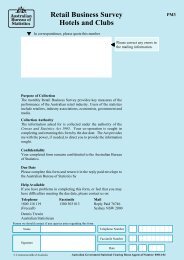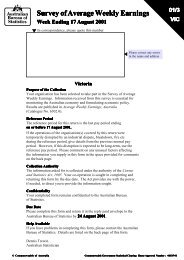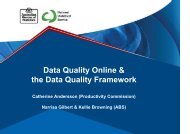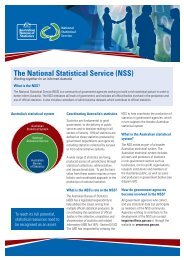SAE Manual Sections 1 to 4_1 (May 06).pdf - National Statistical ...
SAE Manual Sections 1 to 4_1 (May 06).pdf - National Statistical ...
SAE Manual Sections 1 to 4_1 (May 06).pdf - National Statistical ...
Create successful ePaper yourself
Turn your PDF publications into a flip-book with our unique Google optimized e-Paper software.
A Guide <strong>to</strong> Small Area Estimation - Version 1.1 05/05/20<strong>06</strong><br />
then be added <strong>to</strong> the corresponding sample <strong>to</strong>tals <strong>to</strong> form small area estimates. A<br />
potential disadvantage of this approach is that the small area sub-group level model may<br />
be less efficient than a unit level model.<br />
Auxiliary data may be available at area-level or person/unit level or a combination of<br />
both. However, in practice due <strong>to</strong> confidentiality or security reasons, data from<br />
government administrative sources are more likely <strong>to</strong> be available at some aggregated<br />
level. The choice between a unit/person level or area level model will depend on the<br />
level at which data for the variable of interest and explana<strong>to</strong>ry variables are available as<br />
well as the efficiency of the small area estimates generated. For example, if data for<br />
the target variable and the auxiliary variables are only available at the area level, fitting<br />
an area level model will be the only option. However if unit level data is available for<br />
all variables, either an area level or unit level model is an option. It is also possible <strong>to</strong><br />
fit a model in which the target variable is at the unit level but some auxiliary variables<br />
are at the unit level while others are at area level. Further discussion on the choice of<br />
small area model is provided in Section 4.2 below.<br />
In practice, the efficiency of predicted small area estimates may be improved by<br />
including some auxiliary variables as small area averages. Such covariates are referred <strong>to</strong><br />
as contextual effects and may be included as an additional covariate even if the variable<br />
already appears in the model as a unit level auxiliary variable. Contextual effects allow<br />
differences in the area level characteristics in which a person lives <strong>to</strong> be accounted for in<br />
the model. For example, high income earners living in low income areas may have quite<br />
different characteristics <strong>to</strong> people on similarly high incomes living in high income areas,<br />
and it may be important <strong>to</strong> take account of this in the model.<br />
We now give an example of the data sources and auxiliary variables that were considered<br />
for the disability empirical study. The target variable was whether or not a person has a<br />
disability. The auxiliary data was drawn from the survey, a census as well as<br />
administrative data sources and comprised:<br />
- Survey of Disability, Ageing and Carers (SDAC) (ABS, 1998)<br />
- Census of Population and Housing, 2001 (ABS)<br />
- Socio-Economic Indexes For Areas (SEIFA) (ABS)<br />
- Disability Support Pension (DSP) data from Centrelink<br />
Given these sources of data, the following auxiliary variables were considered:<br />
- proportion of people in the small area receiving the DSP,<br />
- age and sex, income, household structure (from SDAC)<br />
- Socio- Economic Indexes For Area (SEIFA) score for the small area,<br />
- Indica<strong>to</strong>r of remoteness<br />
Some of these variables were only available at the area level while those sourced from<br />
SDAC/Census, for example, age, sex and income, were available at the person level.<br />
These SDAC variables were chosen subject <strong>to</strong> the requirement that these variables were<br />
similarly defined and available from the census.<br />
Another key issue relating <strong>to</strong> auxiliary data concerns the case where survey data cannot<br />
be matched <strong>to</strong> auxiliary data sources. In order <strong>to</strong> make predictions for each small area,<br />
auxiliary variables obtained from the survey must correspond closely with similar data<br />
items available for the rest of the population. If this is not the case then model<br />
predictions may be significantly biased. For example in the empirical study of small area<br />
Australian Bureau of Statistics 16








